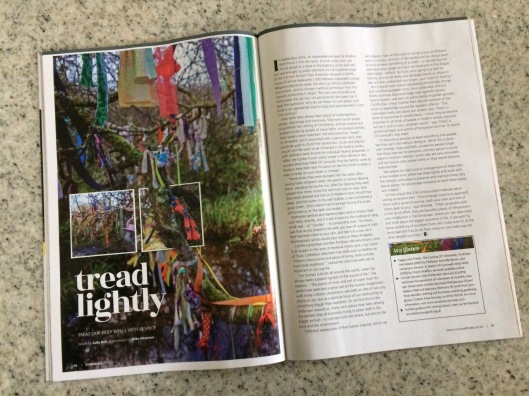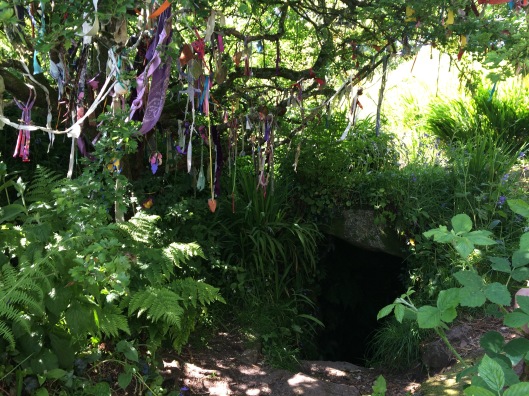Tags
Christianity, Clouties, Cornish Ancient Sites Protection Network, Cornwall, Cornwall Today, Festivals, Heritage, History, Holy wells, Kernow, Matron Well, Pilgrimage, Prayer, Sancreed Well
Holy wells have always been places of contemplation, prayer, pilgrimage and for some, sanctuary. In Cornwall, they were sacred places long before the coming of Christianity, and today the remaining wells are revered and enjoyed by people of many faiths along with the communities that surround them.
In historical context, they were important not only because their waters were “sweet”, or drinkable, but also if they were associated with a particular Saint, their water could be taken to the local Church for use in sacred rites. They became places where local people and pilgrims would come to pray, to be baptised, or be immersed in the healing waters. Different wells were renowned for their different healing properties; in 1894 the Quiller-Couch sisters wrote in their, “Ancient and Holy Wells of Cornwall” that local people made pilgrimages to Madron Holy Well in West Cornwall on the first three Sundays in May in order to cure rickets in children:
“Three times they were plunged into the water, after having been stripped naked; the parent, or person dipping them, standing facing the sun; after the dipping they were passed nine times round the well from east to west; then they were dressed and laid on St Madern’s bed; should they sleep, and the water in the well bubble, it was considered a good omen. Strict silence had to be kept during the entire performance, or the spell was broken.”
Indeed, Methodist services and baptisms were held at Madron Well until fairly recently. And Madron was also known for the tradition of tying small rags – or “clouties” to the surrounding trees – the theory was that as you prayed at the well, you tore off a piece of cloth that had been close to your skin, tied it to a tree, and then as it disintegrated, so too your worry or illness would disappear.
But an unprecedented event at Madron Well in September 2016 thrust it into the news and provoked an extraordinary reaction from local communities. A small metal cross was found glued to a stone in the Baptistry near the well site; this was brought to the attention of the general public via the Facebook page of the Cornish Ancient Sites Protection Network (CASPN), generating outcry. The reasons behind the protest seemed to be multi-faceted – some Pagans found it outrageous that a Christian symbol could be affixed to a site that had pre-Christian origins – although it was attached to the Christian baptistry chapel rather than the wellspring beside which the cloutie trees stand; some Christians found it troubling that someone presumably of their faith might do such a thing, but the real issue was that the site is an official scheduled monument, and legally nothing must ever be done to change a site in any way without permission of the relevant authorities. The cross was removed, the site was not permanently damaged, but it begs the question – if this action was inappropriate in so many ways, then what is an appropriate way to enjoy and venerate these special places in the 21st century? I sought the opinion of two very learned local women to find out.
Cheryl Straffon is a writer, publisher, pagan, Chair of the CASPN and author of “Fentynyow Kernow: In Search of Cornwall’s Holy Wells”. I asked her why the incident at Madron provoked such a reaction?
“CASPN has a lively Facebook community with over 1,500 subscribers who really care about our ancient sites. There’s a sense of ownership of sacred places; people feel that they belong to them and that nobody should do anything to affect them or alter them in any way. I think they have become important to all kinds of people in modern society, because we live in such a crazy, uncertain world, somehow these places which date back in time seem to have a permanence about them. And if you’re leaving bits of cloth tied to a tree, they’re not permanent; they will degrade or can easily be removed if not biodegradable. But this cross was affixed to the stone, and I think it was the permanence of the action that was particularly offensive.
We’ve seen some very strange things left at the sites, underwear and bus tickets, somebody recently left a huge floral tribute that had come from a funeral. But now it’s become so popular to leave something at a site that people feel they can’t visit without leaving something. It’s usually done with sincerity, and hope, and faith, but sometimes people forget that these sites are for everyone. It’s difficult because one person’s detritus is another person’s sacred object. But some sites are very vulnerable, and we’d ask people to respect the fact that these are scheduled sites and their nature must never be changed in any way without permission. We have to clear certain items from the sites or the sites would become overwhelmed. We believe the best kind of management of these sites is the invisible kind, where we tread lightly and work with the relevant authorities to preserve and maintain these very special places. We encourage everyone to treat these places with respect.”
Professor Michelle Brown is an expert in the area of Medieval History and also sits on the committee of CASPN. She’s a Lay Canon of Truro Cathedral and Professor Emerita of the School of Advanced Study, University of London. I started by asking her why holy wells are so important in our psyche?
“For human cultures all around the world, water has always been a potent symbol of the source of life. Therefore, sites associated with water and the point of entry and exit of water from the earth have been places that have exercised a great call on the human spiritual imagination. Many cultures, right back into antiquity, have chosen to see wells as sites of not only practical use, but as a spiritual focus of our relationship to something bigger than ourselves. So we find that around the world and in Cornwall in the landscape around us there are many such places that have been among the earliest sites of humanity trying to place itself in the bigger picture.
And perhaps to try to connect with the divine? “Yes, to connect with the divine, but also to the land and the environment. And so different expressions of that human impulse, which we call religions, have all focused on similar places at different points in history. And one of the tendencies has always been to want to leave something of yourself – or something that symbolises your prayer and your personal part in that bigger relationship – behind. Within a Christian context, the votive offerings become known as clouties. So if you were going to a well for healing, you would leave your bandage tied to an adjacent tree and that symbolised your prayer, your hope for healing. And taking the holy waters was part of that holistic healing of spirit and body. Many of the early wells, such as Madron, had Baptistries associated with them, and people across the centuries have carried on using them.
So in the 21st century, what’s important about the wells to you? “They are genuine and authentic places in our landscape where we can celebrate our humanity and our reaching out to place ourselves in a bigger picture both within our environment and the divine, the creative force. They’re deep waters that we can all dip into and that can sustain and refresh us all. They’re important as places in our landscape that celebrate our interaction with and sensitivity to that landscape, and as such they need to be carefully respected and although everybody can share them they should be recognised as historic monuments and places of living, multi-cultural, multi-faith traditions.”
And you’ve seen some pretty strange things being left at sites from time to time. “Yes, we’ve seen everything from black bandages, underwear and burnt offerings to beautiful dream catchers and palm crosses. In one case we found an entire family of garden gnomes! Sadly we also see a great deal of plastic items. We would always encourage people to tread lightly, and if things are left that aren’t biodegradable, CASPN will periodically clear them away”.
So if members of the public want to come and enjoy these sites, what is an appropriate way of going about it? “I’d encourage anyone wanting to visit our ancient sites to approach them with a sense of journey; both your journey and those of others dear to you. They’re good places to travel to, often they’re accessible with a little bit of effort, and they’re beautiful places of refreshment and thoughtful mindfulness in the landscape where you can take stock and think about the bigger questions of life. If we want to leave something of ourselves there, let’s make sure it’s of the landscape and that as we then move on, we make way for other people’s journeys.
At a glance:
Michelle’s book, “Pagans and Priests: the Coming of Christianity to Britain and Ireland” (2009) is readily available online, as is Cheryl’s book “Fentynyow Kernow: In Search of Cornwall’s Holy Wells” (2005).
For more information about the Cornish Ancient Sites Protection Network and a list of forthcoming events, see www.cornishancientsites.com. CASPN welcomes the assistance of volunteers at monthly clear-ups; the next clear-up will be at Sancreed Well on January 15 at 2pm, and a clear-up at Madron Well and Baptistry will be held on February 19 at 2pm. If you have any queries in advance, please contact Dave Munday on 01736 787 230 or email him at dave@cornishancientsites.com. Do wear sensible clothing and footwear and please bring gardening gloves.
Guidance for visiting historic sites can be found on the Historic England website: www.historicengland.org.uk
© Sally Bell 2017
Originally published in Cornwall Today



This expresses the issue so well.
LikeLike
Thank you for this. We are headed for Sancreed this week end ❤☉👣
LikeLike
Thank you so much for taking the time to get in touch! Are you local? If so don’t miss the 3 Wells Walk on the first Sunday in May, it leaves from Sancreed & is such a special day. I love Sancreed – though I was born in Aus I can trace my ancestry there to the 1500s. Enjoy it & have a wonderful weekend 😊🌞❤
LikeLiked by 1 person
Thank you 😊X
LikeLike